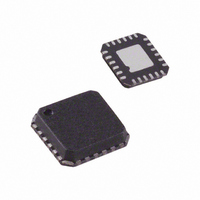ADL5387ACPZ-WP Analog Devices Inc, ADL5387ACPZ-WP Datasheet - Page 14

ADL5387ACPZ-WP
Manufacturer Part Number
ADL5387ACPZ-WP
Description
IC, QUAD DEMODULATOR 50MHZ-2GHZ LFCSP-24
Manufacturer
Analog Devices Inc
Datasheet
1.ADL5387ACPZ-R7.pdf
(28 pages)
Specifications of ADL5387ACPZ-WP
Frequency Range
50MHz To 2GHz
Rf Type
Quadrature
Supply Voltage Range
4.75V To 5.25V
Rf Ic Case Style
LFCSP
No. Of Pins
24
Operating Temperature Range
-40°C To +85°C
Function
Demodulator
Lo Frequency
100MHz ~ 2GHz
Rf Frequency
50MHz ~ 2GHz
P1db
12.8dBm
Gain
3.8dB
Noise Figure
16.5dB
Current - Supply
180mA
Voltage - Supply
4.75 V ~ 5.25 V
Package / Case
24-VFQFN, 24-CSP Exposed Pad
Rohs Compliant
Yes
Lead Free Status / RoHS Status
Lead free / RoHS Compliant
Available stocks
Company
Part Number
Manufacturer
Quantity
Price
Company:
Part Number:
ADL5387ACPZ-WP
Manufacturer:
ADI
Quantity:
249
ADL5387
CIRCUIT DESCRIPTION
The ADL5387 can be divided into five sections: the local
oscillator (LO) interface, the RF voltage-to-current (V-to-I)
converter, the mixers, the differential emitter follower outputs,
and the bias circuit. A detailed block diagram of the device is
shown in Figure 45.
The LO interface generates two LO signals at 90° of phase
difference to drive two mixers in quadrature. RF signals are
converted into currents by the V-to-I converters that feed into
the two mixers. The differential I and Q outputs of the mixers
are buffered via emitter followers. Reference currents to each
section are generated by the bias circuit. A detailed description
of each section follows.
LO INTERFACE
The LO interface consists of a buffer amplifier followed by a
frequency divider that generate two carriers at half the input
frequency and in quadrature with each other. Each carrier is
then amplified and amplitude-limited to drive the double-
balanced mixers.
RFIN
RFIP
Figure 45. Block Diagram
PHASE SPLITTER
DIVIDE-BY-TWO
QUADRATURE
BIAS
IHI
ILO
LOIP
LOIN
QHI
QLO
Rev. 0 | Page 14 of 28
V-TO-I CONVERTER
The differential RF input signal is applied to a resistively
degenerated common base stage, which converts the differential
input voltage to output currents. The output currents then
modulate the two half-frequency LO carriers in the mixer stage.
MIXERS
The ADL5387 has two double-balanced mixers: one for the
in-phase channel (I channel) and one for the quadrature channel
(Q channel). These mixers are based on the Gilbert cell design
of four cross-connected transistors. The output currents from
the two mixers are summed together in the resistive loads that
then feed into the subsequent emitter follower buffers.
EMITTER FOLLOWER BUFFERS
The output emitter followers drive the differential I and Q
signals off-chip. The output impedance is set by on-chip 25 Ω
series resistors that yield a 50 Ω differential output impedance
for each baseband port. The fixed output impedance forms a
voltage divider with the load impedance that reduces the effective
gain. For example, a 500 Ω differential load has 1 dB lower
effective gain than a high (10 kΩ) differential load impedance.
BIAS CIRCUIT
A band gap reference circuit generates the proportional-to-
absolute temperature (PTAT) as well as temperature-independent
reference currents used by different sections. The mixer current
can be reduced via an external resistor between the BIAS pin
and ground. When the BIAS pin is open, the mixer runs at
maximum current and hence the greatest dynamic range. The
mixer current can be reduced by placing a resistance to ground;
therefore, reducing overall power consumption, noise figure,
and IIP3. The effect on each of these parameters is shown in
Figure 10, Figure 13, and Figure 14.













